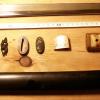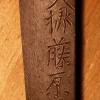Hi, Found a sword in fairly poor state minus a few bits and pieces in a pawn shop. I have a strong suspicion that it is Japanese, it has Japanese text on the tang. Sad that it wasn't in a complete state and has some damage to the tip. Seems amazingly sharp where the blade is free of corrosion. I would like to restore it, it gives me the impression that it was made with great care. Any comments would be gladly accepted. Please see the attached image. James |
|||
 |
Nihonto ClubJapanese Sword Information Exchange |
User login |
|
|
Disclaimer: Nihontō Club owners and independent contributors will not be held responsible for any loss, damage or inconvenience caused as a result of any inaccuracy or error within this website. Except where otherwise noted, this page is licensed under a Creative Commons License.
|



don't touch
Hi,
Just a quick note (more later tonight):
DO NOT try to fix or restore anything yourself.
DO NOT remove rust.
DO NOT use ANY type of abrasive on it.
A proper "restoration" of this blade must be done by a real togishi (polisher), and it would be very expensive.
Pete
Masanori
The signature is "YAMATO DAIJOu FUJIWARA MASANORI".
See MAS738 and MAS739.
It is clearly an old Japanese sword, and if the signature is valid, it probably dates from the 17th century.
See various web sites for how to take care of it (and also some older posts on this site).
Pete
condition
BTW, you said "fairly poor state", but from what I see in the pictures, the condition is pretty good.
"When 300 years you become, look as good you will not." :-)
You may want to post close-up pictures of the blade, including the tip, and the metal accessories (habaki, fuchi, kashira, menuki).
Looks like the tsuba (hand guard) is the only major piece missing.
It is a "katana".
Since the tang has a square end, it likely means that the tang was cut off a bit to make it shorter. This is called "suriage".
Pete
Sincere Apologies
Pete,
I am already in the process of attempting to remove the rust, I started before I found this online forum.
I realise from your responses that you are greatly passionate about Japanese swords and I am assuming at this point you are probably throwing up your hands and @#$&% ...
Therefore, my apologies.
There don't seem to be any Togishi in South Africa that I can call on for assistance however.
The rust started at the point and worked its way accross the Boshi and on to the edge and the Mune. It did not cross the Yokote however. My guess is that it happened because the Saya was damaged on the Kojiri and had split open allowing the blade to be exposed to the elements.
When I found the sword, it had no oil on on it and I don't think it had been oiled for some time unfortunately.
I am not a metal smith, I have no experience of Japanese swordsmithing. I see from the research I have done that it takes 10 years or more of apprenticeship to a Togishi to be considered as having some skill in this field.
I'm hoping that a few things may count slightly in my favour though. Though I have already started removing the rust, I'm not in a hurry to complete the task. I am not attempting to re-shape the blade, just reveal the non-oxidised steel beneath the rust using the finest waterstone I have (a lansky 600grit) for now.
It would be a shame to see an object made with obvious skill and passion destroyed by rust. But, point taken it would be an equal shame to have the same object defaced by an idiot.
Thank you for your replies, for confirming what I thought I had found out about the sword and for explaining the square end of the Tang. Why might this have been done?
I see from the forum that 大和大掾藤原正則 yamato daijō fujiwara masanori disambiguation is slightly complicated by the fact that a father and a son may have used the same / similar Mei's.
It would be great to find the Tsuba and any additional spacers that may also have been with the sword originally, I will take a trip back to the Pawnshop to see if they might be there.
My wife told me she felt that the sword gave her the impression that it came with great responsibility, I am beginning to understand she was right.
James
shortening
Regarding shortening:
I think the most common reason was to make the blade fit into a particular "style" of koshirae (koshirae = the scabbard, handle, tsuba, and various decorations).
For example, some very old blades that were originally quite long, and were meant to be worn edge-downward (good for horseback), were later shortened and worn edge-upward, inserted through the belt.
I'm guessing that yours was only shortened a little bit, but I'm not sure. If it was shortened a lot, it would have been necessary to re-carve the signature. Many shortened blades have more than one mekugi-ana (hole in the tang for mounting the handle).
OR, it's possible that this smith made the tang with a square end on purpose (but that's very unusual, I think).
Oil:
You can use "Japanese sword oil", found in "sword cleaning kits" from internet vendors. It is called "choji oil" (choji = clove flower). It's really just some type of mineral oil with clove oil scent added.
Another option is to use a Good Quality gun oil (I use a brand called "Break Free").
DO NOT use ordinary lubricating oil, or motor oil, etc. Those oils tend to attract moisture and dust.
Pete
Thanks
Thanks Pete.